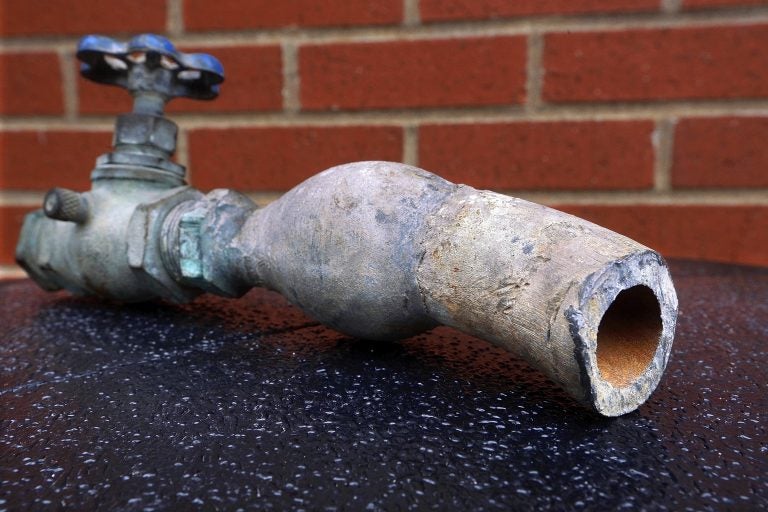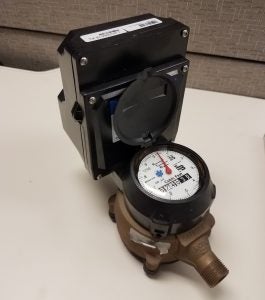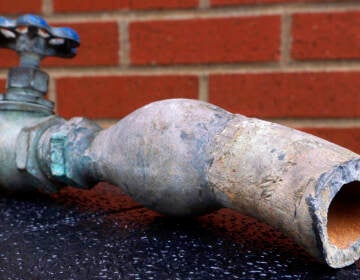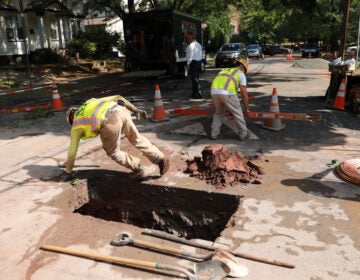While updating water meters, Philadelphia will develop database of city’s lead pipes
As part of its meter upgrade initiative, the Philadelphia Water Department will look for lead service lines inside homes and log the ones it finds.

An example of lead pipes that deliver water to the nation's homes is on display. (Seth Perlman/AP Photo)
An initiative by the Philadelphia Water Department to upgrade some 480,000 water meters will have an added benefit: It will allow the city to develop an inventory of lead service lines.
The department estimates that 20,000 homes in the city have lead service lines, the pipes that connect the homes to the water mains and are the responsibility of the homeowner. But the department does not have a list of those homes’ specific locations.
The meter upgrade will change that. Beginning in early 2020, technicians from the Water Department will go to Philadelphia residents’ homes to upgrade the radio transmitters in their water meters, which were last upgraded between 1997 and 1999.
As the technicians replace the transmitters, they will also check the service lines and log the material the lines are made from using a dropdown box on their tablets.
“So as they complete the work order, we’ll capture that information digitally,” said Gary Gehringer, project manager at the Water Department.
Over the course of two to three years, that information will be compiled into a database of lead service lines across the city.
“We are looking forward to getting a better idea of what’s actually out there in our system,” said Water Department supervisor Matt Fulmer, “and it’ll allow us to better inform our customers.”
But the database will come with caveats. Most of the typical service line is underground, so a technician will be able to see only a few inches to a foot of it inside a basement.
“We have to be careful to be honest and accurate with homeowners,” said Gary Burlingame, director of the Water Department’s Bureau of Laboratory Services. “We can tell you what we see, but we can’t always guarantee 100% what’s buried in the ground between the water meter and the water main.”
That means the database could overlook homes where the pipe was replaced inside, but lead remains in a portion of the pipe beneath the sidewalk.

Service lines are also the homeowner’s responsibility, so if a lead line is found during the meter replacement, it will be up to the homeowner to replace it.
Nevertheless, lead watchdogs think creating an inventory of lead service lines, even an incomplete one, is a step in the right direction.
“It’s very good that the Water Department is building this inventory,” said Maurice Sampson, eastern Pennsylvania director of Clean Water Action. “If you want to address the problem, the first thing you really need is an inventory of where all the lead lines are.”
The challenge, Sampson said, is figuring out how to make use of that information — and whether and how to make it public. He said some residents will be hesitant to make any information about their home public; on the other hand, the information is important in both the remediation and study of lead.
Sampson suggested the department might report out the lead lines by census district.
“If they do that, it keeps the privacy, and it allows us to compare that data with all the data we collect on health and [lead] poisoning and everything else, which is all organized by census district,” he said. “We think that that’s a good compromise.”
What is also unclear is how the inventory will play into housing regulations. Federal law requires previous owners or landlords of homes built before 1978 to report the presence of lead if they know about it. The requirement was written to address lead paint, but Sampson said it isn’t immediately clear whether it would or could apply to pipes cataloged in the Water Department’s database.
To help defray replacement costs for homeowners who discover they have lead service lines, the Water Department offers a no-interest HELP loan program. As of January 2019, the department reported 190 homes had replaced lead service lines through the program.
The department will also leave flushing instructions with residents with lead lines — telling them to run the tap for at least three to five minutes any time the water hasn’t been used for six hours or more. Fulmer said the hope was this would help in instances in which the tenant and homeowner were not the same so that a renter could both be aware and take steps to mitigate the risk.
For the database to be as complete as possible, residents will need to let Water Department technicians into their homes to upgrade the meters. The department plans to reach out to residents through their water bills, letters, phone calls, and house calls.
“It’s a really robust communications plan,” Gehringer said.
Colleen McCauley, health policy director at Public Citizens for Children and Youth, said she was glad to hear the city was making lead a priority.
“I think it’s a great sign that the city is taking the issue of lead poisoning seriously, looking for all sources in the city,” she said. “That’s really important.”
WHYY is your source for fact-based, in-depth journalism and information. As a nonprofit organization, we rely on financial support from readers like you. Please give today.




